The dachshund is one of the most endearing breeds in the world. Just try to look at the photo above without smiling – you can’t do it, can ya?
Long, lean, and lovable, dachshunds – also called dachshund dogs or wiener dogs — can make great pets, but you need to make sure that you’ll enjoy their personalities and be able to meet their needs before adding one to your family.
You’ll also have to decide what kind of dachshund you want to add to your pack, as they come in several different varieties.
We’ll try to help you figure these things out below, as we talk about the general characteristics of the breed and explain the different types that are available.
Dachshund Dog Basics
Like most other breeds, dachshunds have a number of traits that make them awesome pets, but they can also present some challenges to their peeps, so it is important to familiarize yourself with the history, personality, health issues, and care requirements of the breed.
Dachshund Pronunciation: How Do You Even Say That Word?!?
Before going further, let’s make sure we’re all on the same page and pronouncing this breed name properly.
Personally, I’ve always pronounced this breed name as dock sun.
However, Merriam-Webster seems to want two consonants at the end, although the dictionary does say that either däks-hu̇nd or däks-hu̇nt is acceptable. In either case, the “ch” sounds like a hard “k,” and the “h” after the “s” is silent.
If you’re one of the many (like me) who don’t really find phonetic spelling helpful, just go listen to the pronunciations here. Or, we can all just agree to call them wiener dogs and move on.
History of the Breed (Including the “Dachshund” Meaning)
The origin of the dachshund is a bit murky, and the earliest forebearers of the breed are thought to have originated in Egypt. However, modern dachshunds appear to have been developed in Germany way back in the early 1700s.
They were originally developed to be scent-hunting hounds, and their long and lean bodies made them very well-suited for dispatching badgers(!), rabbits, and other tunneling critters. In fact, the word “dachshund” means “badger dog” in German. Some people even used packs of dachshunds to trail wild boar.
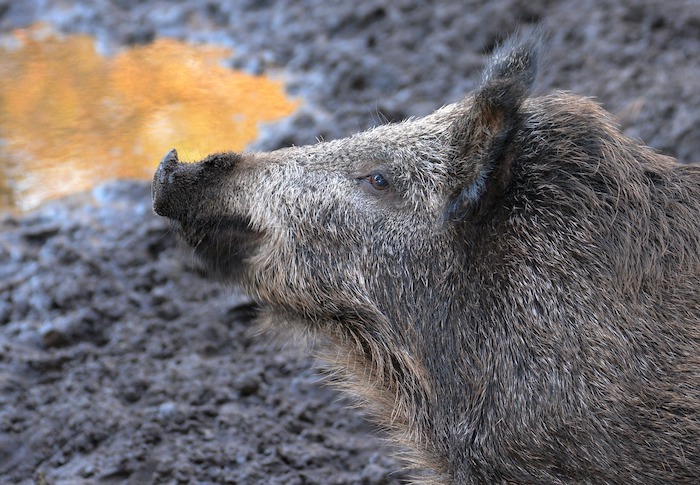
Dachshunds were a decidedly German breed, who weren’t terribly well known outside of Europe for many years. However, they started appearing in the U.S. around the turn of the 19th century. They became an immediate hit, and the AKC started recognizing them in 1885.
The Dachshund Temperament and Personality
Despite their loving facial expressions and too-cute-for-words appearance, dachshunds are surprisingly bold pups. The AKC actually describes them as “brave to the point of rashness.”
This bravery is a result of their hunting history, as is their impressive intelligence, which was important for dogs who were often expected to hunt on their own, without their owner’s guidance.
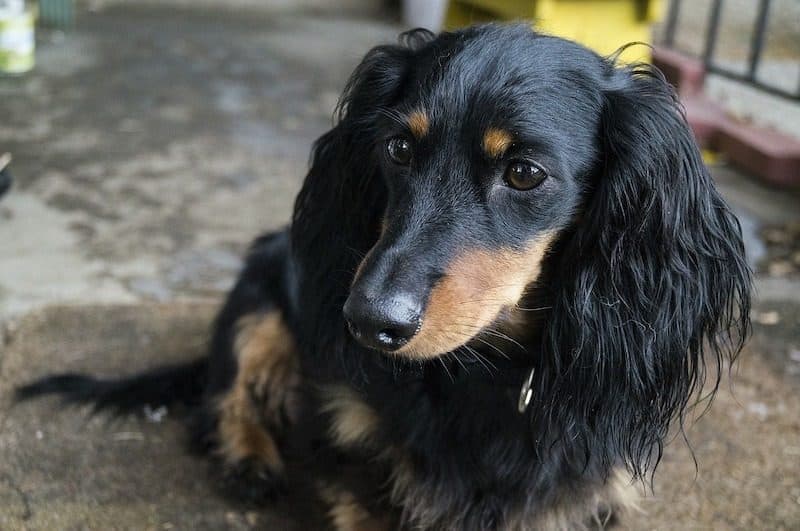
This means that modern dachshunds are often quick learners, but they also march to the beat of their own drummer, which can occasionally make training them tricky.
But despite this, dachshunds are definitely people-oriented dogs who usually love hanging out with their families. They may, however, single out a single person as their favorite. Some dachshunds may even become jealous or act out if their favorite person starts doling out love to other pets.

Dachshunds are actually very effective watchdogs, as they are vigilant observers, who won’t hesitate to show off their surprisingly deep barks.
This is important for prospective owners to note, as dachshunds are one of the most vocal breeds, and their frequent barking may irritate neighbors.
Dachshund Health Issues
Dachshunds are typically healthy dogs, but there are a few health problems you’ll want to watch for.
For example, because of their long spines, dachshunds are very susceptible to back problems.

Accordingly, you’ll need to monitor your pet’s body weight and food intake closely to ensure your pet’s skeleton isn’t having to support more weight than it should.
Additionally, it is imperative that you prevent your dachshund from jumping down from high places (like your couch or bed) or standing up on his back legs.
It’s typically wise to install stairs or ramps to help your pooch get around the house without having to jump. Make sure you support your pet’s back when carrying him too.
One of the most important things to note is that dachshunds are susceptible to bloat – a potentially fatal medical emergency, which occurs when a dog’s stomach fills with gas and twists on its axis. Bloat is typically most common in large breeds, but it is also a concern for dachshunds because of their deep chests and unusual builds.
Dachshunds may also suffer from epilepsy, and overweight individuals may develop diabetes.
Dachshund Care Requirements
Dachshunds can certainly make great pets, but it is important to note that they have a few unique care requirements, which you’ll need to be willing to satisfy before adding one to your family.
Dachshunds are playful pups, but they aren’t an especially high-energy breed, so they don’t need as much exercise as some other dogs do. A couple of daily walks and some playtime around the house or backyard will usually keep them adequately exercised.
It is important to keep them warm when playing outdoors in cool weather, as dachshunds can become chilled easily. A doggie winter jacket may be in order for colder weather!
Housetraining is one of the biggest challenges of dachshund ownership, as they frequently struggle to learn proper pooping and peeing protocols. Crate training is often helpful, and some owners find it necessary to use dog diapers or belly bands to prevent their pooch from soiling the home on a regular basis.
It is also important to socialize your dachshund from a young age. Otherwise, they can become nervous when meeting new people. In extreme cases, this can cause your pet to become nippy and untrustworthy with unfamiliar two-footers. However, with proper socialization, they are often very well-behaved with family children.
It is important to keep dachshunds leashed when you’re not home or in a fenced area, as they love exploring on their own and chasing perceived prey, such as squirrels or chipmunks.

Types of Dachshund Dogs
If, after reading about the characteristics of dachshunds above, you think your family is well-suited for the breed, you can start trying to pick one out.
But before doing so, you’ll need to decide what type of dachshund you want, as they come in many different “flavors.”
We’ll discuss some of the most common varieties below.
Three Different Dachshund Sizes
Dachshunds are pretty small pups, but they actually vary in size more than many people would think. In fact, they fall into several different size classes, which vary from one breed registry and club to the next.
AKC Dachshund Classifications
The AKC only recognizes one size classification – the standard dachshund, which is usually between 16 and 32 pounds. However, dogs who are 11 pounds or less at 12 months of age, may compete in a “miniature” class division.
UKC Dachshund Classifications
The UKC fully recognizes two size classes, with nearly identical weight ranges. However, the UKC caps the high-end of the weight range for standard dachshunds at 25 pounds. Dachshunds of 11 pounds or less are considered “miniature,” with the ideal weight being 10 pounds.
Colloquially, dachshund owners and breed enthusiasts often refer to pups between 11 and 16 pounds as “tweenies.”
This results in the following sizes:
- Miniature – Dachshunds who are 11 pounds or less upon reaching maturity are placed in the miniature category.
- Tweenie – “Tweenies” are dachshunds between 11 and 16 pounds.
- Standard – The largest dachshunds – those weighing between 16 and 32 pounds — are considered to be in the “standard” size class.
Fédération Cynologique Dachshund Classifications
Meanwhile, The Fédération Cynologique categorizes dachshunds into two primary size classes: Standard (Normalgrossteckel) and Miniature. Standards are between 16 and 32 pounds, while miniature dachshunds are 11 pounds or less.
However, miniature dachshunds are further subdivided into two size classes based on their size at 15 months of age:
- the dwarf dachshund (Zwergteckel)
- the rabbit dachshund (kaninchen).
The rabbit or kaninchen dachshund is the smaller of the two. Male rabbit dachshunds must weigh less than 7.7 pounds (females must weigh less than 6.6 pounds) and have chests that measure less than 11.8 inches.
As you can see, three of the leading breed registries recognize pretty similar size classes, although there are some subtle differences. However, there are a bunch of breed registries in the world, and at least one – the United Canine Association – recognizes an even smaller size class: The toy dachshund, which weighs 8 pounds or less.
Three Different Dachshund Coats
Dachshunds typically have coats that fall into one of three categories: smooth-haired, wire-haired, and long-haired.
We’ll discuss each in greater detail below.
Smooth-Haired Dachshunds
The majority of U.S. dachshunds have smooth coats. These coats are soft, short, shiny, and dense. They also require very little grooming.
Smooth-haired dachshunds (sometimes simply called smooth dachshunds) have ears that are sometimes described as “leathery looking” and relatively long hair on their bellies.

Long-Haired Dachshunds
Long-haired dachshunds have long, silky hair, which was likely developed to protect these hunting dogs from the elements.
The long hair is most noticeable on the tail, ears, neck, behind the legs, and beneath the belly. Long-haired dachshunds require frequent brushing and grooming to keep their coat in good condition.
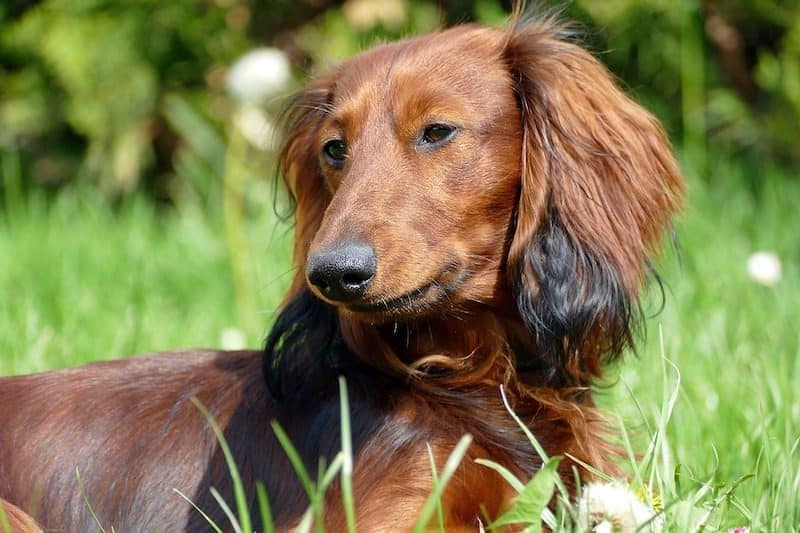
Wire-Haired Dachshunds
Wire-haired dachshunds have medium-length, coarse, slightly wavy hair that gives them a “rough” appearance. They also have (amazingly cute) facial hair, which makes them pretty easy to recognize.
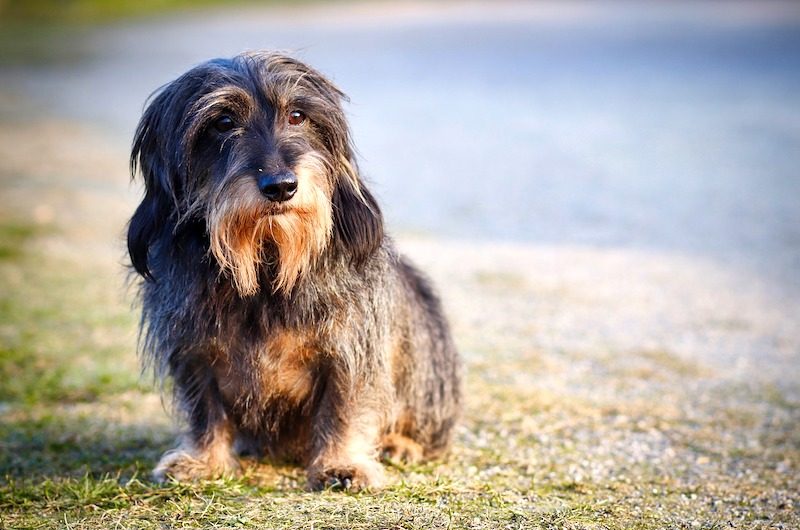
Dachshund Colors
Dachshunds come in an array of colors and patterns. Some of the most popular colors include:
- Black & Cream
- Black & Tan
- Blue & Cream
- Blue & Tan
- Chocolate & Cream
- Chocolate & Tan
- Cream
- Fawn & Cream
- Fawn & Tan
- Red
- Wheaton
- Wild Boar
wild boar black and tan chocolate and tan cream
You may also be able to find dachshunds in non-standard colors, such as black, chocolate, and fawn. These dogs may not be eligible for some dog shows, but there’s no reason to avoid getting a fawn-colored dachshund for a pet if that’s what you want.
Dachshunds are also available in three different standard color patterns: brindle, dapple, and sable.
Brindle
Dark stripes found throughout the coat

Sable
Dark-tipped hairs on a red coat

Dachshunds also come in three non-standard patterns:
- Piebald – Piebald dachshunds are covered in conspicuous white patches.
- Brindle Piebald – Brindle piebald dachshunds have brindle patterns and conspicuous white patches.
- Double Dapple – Double dapple dachshunds look similar to dapple dachshunds, but they have more white blotches.
Note that double dapple dachshunds are susceptible to a variety of health problems, including deafness, blindness, or even missing eyes. Accordingly, some breed registries will not register dapple dachshunds.
***
There’s a lot to like about the dachshund’s personality, and they’re certainly cute pups, who are available in a number of different colors, patterns, and coat lengths. But make sure that you are willing to address the challenges this breed sometimes presents before adding one to your family.
There are also quite a few common dachshund mixes available. We’ve written about some of the most popular (and adorable) dachshund mixes before, so be sure to check them out before you set your sights on a specific dog.
We even wrote up an entire article about the chiweenie, which is a dachshund-Chihuahua mix!
Do you already have a dachshund? Tell us all about him or her! We’d love to know what color, pattern, and size you have, as well as some of the things you like most about your pup.




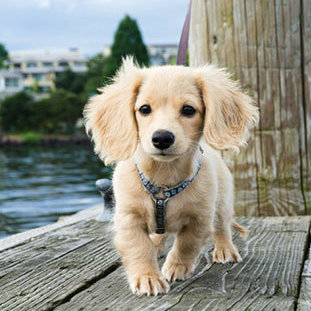
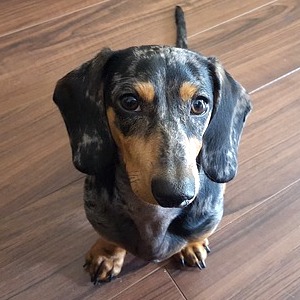







15 Comments
March 12, 2022
Nicely written. One comment – I would say smooth haired ears are better described as velvety rather than leathery.
March 14, 2022
Thanks for the kind words, Steve. And sure, I can see “velvety” being a good word too.
December 18, 2021
Not badly written, but the photo of your Brindle is terrible. He looks more like a solid. I own a Brindle, his name is Diesel, and would love to share with you his photos. He is a breeding male and has passed his beautiful colour on to Manu puppies. I also own a 10 month old chocolate and tan dapple female named Mia.
December 20, 2021
I don’t know that I’d consider it “terrible,” Sheila, but we’d love to see your pooch!
Head over to our photo uploader to share some pics.
🙂
June 19, 2021
Greatly enjoyed your article, however, I guess my black n tan miniature wired hair must be a one off. He seldom barks. He only barks at big dogs and when he feels threatened.
He believes it’s in his Bill of Rights to share our king-sized bed.
Coincidentally, today is his 10th BDay. So, we gotta get up and get Spikes’ special day started! Ya’ll have a great day.
June 21, 2021
Spike sounds great, David! And sure — dogs are all individuals who vary in scads of different ways.
Wish Spike a happy 10th birthday for us! Scritches and treats all around!
March 26, 2021
I thought we got a mini but realize now he is a tweenie. This article is on point. I have a red, long haired male. He is quiet, loving, sociable, intelligent, and is the hardest dog to potty train I have ever had in my 70 years. I am his person and couldn’t be happier with my first time with this breed.
March 26, 2021
Glad you enjoyed the article, Liana!
February 4, 2021
Your article was spot on. Every sentence was confirming my knowledge of our 7 month old wiener/ pit bull. He was brought to us unexpectedly. But it after day two we new he found his family. His name is buddy. Like you said in other words is stubbornness. Patience is vital! But he is so beautiful. I never looked at a dog and thought he was handsome. But he is .
I’m so glad I read this article because I wasn’t aware of a lot of things that need to be known.thanks! So he is a very healthy boy. He is about 22” long. Sawed off legs , very broad and muscular chest with a white strip from his chest to his behind. He has at least three different shades of brown, it’s shiny. His teeth are rather large. For seven months, I’m impressed. He is lean so I guesstimate around 30 lbs. he looks just like a Labrador with the long body. Ears are short. Must be from his mother, who reportedly had 23 puppies. My dog was first picked, but ended up giving him to us, I still ended up paying over a 100$ because the guy kept trying to make a decision on ownership. We adore him and glad to be apart of your helpful emails. :)!
January 29, 2021
My daughter and I got our first smooth-haired Dashchund back in Sept 2020. We chose this breed for their personality, no grooming requirements, low/no odor and very minimal shedding. We love Roscoe so much, probably too much, lol. He’s a very small chocolate/tan dapple mini boy with a loving and friendly personality. He loves to give kisses, squeak his skineez toy and fret the family felines. He sleeps under the covers with my daughter, I think he would lay all day with her. She is his person ❤. Def best decision to have him join our family.
August 19, 2020
I had a mini smooth Red, my favorite she was 16 she passed away this year .Never had a problem with her, Potty training. was easy. Never had a problem with her barking. Very socialized. Loved everybody she met very good with my grandbabies. Miss her so much. She love going to the racetrack getting all the attention in her stroller. She slept in a bassinet right by my bed. I am now looking for one the same as her I wanna read smooth short hair mini.Best dog ever.Love this breed.
August 19, 2020
Sounds like she was a wonderful pooch, Heather. Thanks for sharing and best of luck adding a new pooch to your home!
August 2, 2020
Hi my name is Lucy! I am a long haired redhead. I love my Mommy the best! I also enjoy kayaking with her, any chance I get. My Mom’s name is Debbie. I have one favorite toy a Skunk. It’s flat so I fold it in thirds and walk around the house with it. Well, that’s all about me, but my Mom loves me to bits, and I love her!
June 17, 2020
I have a miniature long haired black and tan dachshund. She is a fearless hunter and a great watchdog. She’s the most loving little dog I’ve ever had.
January 16, 2020
I have 2 minature daschunds…Scooter and Frank they make my life Complete…Love Love Love Them